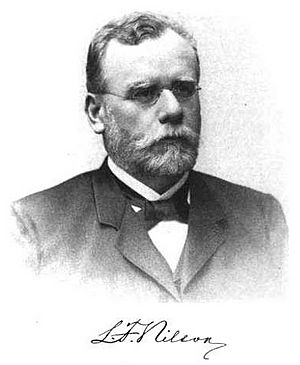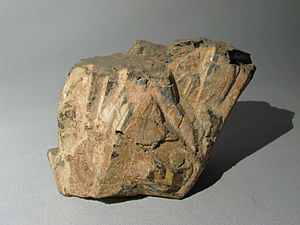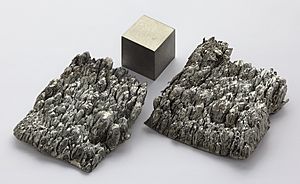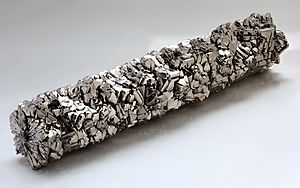Lars Fredrik Nilson facts for kids
Quick facts for kids
Lars Fredrik Nilson
|
|
|---|---|

Lars Fredrik Nilson
|
|
| Born | 27 May 1840 Skönberga, Östergötland, Sweden
|
| Died | 14 May 1899 (aged 58) Stockholm, Sweden
|
| Nationality | Swedish |
| Alma mater | Uppsala University |
| Known for | Discovery of scandium, agricultural chemistry |
| Children | Gunnar Nilson |
| Scientific career | |
| Institutions | Royal Swedish Academy of Agriculture and Forestry |
| Doctoral advisor | Lars Fredrik Svanberg |
Lars Fredrik Nilson (May 27, 1840 – May 14, 1899) was a Swedish chemist. He was a professor at Uppsala University. Later, he became the Director of the Agricultural Chemical Experiment Station in Stockholm.
Nilson is famous for discovering the element scandium in 1879. He found it by separating out scandium(III) oxide, also called scandia. Besides his work with elements, he also helped Swedish agriculture a lot. He improved farming methods and introduced new crops like sugar beets.
Contents
Becoming a Chemist
Lars Fredrik Nilson was born in a place called Skönberga in Sweden. His family later moved to an island named Gotland. His father owned a farm there. Lars Nilson loved Gotland and visited his small farm there every year.
After finishing high school, Nilson went to Uppsala University in 1859. He studied natural sciences, including animals and plants. His work in mineralogy (the study of minerals) caught the eye of his chemistry professor, Lars Fredrik Svanberg.
In Sweden, to get a doctorate, students had to pass many exams in different subjects. In 1865, just before Nilson's last exam, his father became very ill. Nilson went home to Gotland to help with the farm. He worked hard in the fields. When his father got better, Nilson had successfully managed the farm. He even brought the first engine threshing machine to Gotland. Working on the farm made Nilson much stronger and healthier. He returned to Uppsala and became a doctor of chemistry in 1866.
A Career in Science
In 1866, Nilson became a chemistry professor at Uppsala. He was a calm and patient teacher. He liked to show students how things worked rather than just giving lectures. He believed that once the workday was over, people should relax and not talk about work. His first research papers were about sulfides and selenous acid.
Discovering New Elements
In 1874, Nilson became a professor of general and agricultural chemistry at Uppsala. This allowed him more time for research. He started studying rare earth elements. These are a special group of elements that are hard to find and separate. He wanted to understand how new elements fit into the periodic system (the chart of all known elements).
In 1879, Nilson made a big discovery. He separated out an oxide called scandia. By doing this, he found a brand new element, which he named scandium. He chose the name "scandium" after Scandinavia, where he lived. This discovery was very important because a scientist named Dmitri Mendeleev had predicted that an element with these exact properties should exist. Mendeleev called it "ekaboron" based on his periodic system.
Nilson's tests showed a new pattern of lines, proving it was a new element. Another scientist, Per Theodor Cleve, later showed that Nilson's scandium was indeed the "ekaboron" that Mendeleev had predicted.
Nilson and his colleague Sven Otto Pettersson were also the first to get titanium metal in a fairly pure form in 1887. Before them, Jöns Jacob Berzelius had isolated titanium in 1825, but it was not very pure.
Nilson also studied how dense (heavy for its size) metal gases were. This helped scientists figure out the valence of different metals. Valence tells us how many chemical bonds an atom can form.
Helping Farmers
From 1878 to 1883, Nilson was a professor of analytical chemistry at Uppsala. Then, he became a professor of chemistry at the Royal Swedish Academy of Agriculture and Forestry in Stockholm. He also became the Director of the Agricultural Chemical Experiment Station.
As an agricultural chemist, he wrote almost sixty papers about topics like soils and fertilizers. Because of his research, many swampy areas in Gotland were drained and turned into farmland. He also helped introduce sugar beets as a major crop. He showed how to treat chalky lands with potash fertilizers to make them better for farming.
He also studied cow's milk and different plants used to feed cattle.
Lars Fredrik Nilson was a member of several important science groups. He also received awards, including the Order of the Polar Star.
Images for kids
See also
 In Spanish: Lars Fredrik Nilson para niños
In Spanish: Lars Fredrik Nilson para niños







